Long bean is a variety of beans, which looks much thinner and longer than the others. Mostly they are growing in Asian countries as they love to grow in warm conditions. But still, you can grow long beans in any part of the world.
Here’s how to grow long beans.
- Dig a 1-foot deep hole and fill halfway from compost and the rest with garden soil.
- Sow long bean seeds 1 inch deep and water them well.
- Support long bean plant from a stake once they get into 5 inches.
- Use a low Nitrogen fertilizer for a quick and better growing.
- Water them 2 inches in every week.
- Care the long bean plant from insects and pests.
- Grow right companion plants to increase pollination and healthiness.
- Harvest the long beans once they are 1 foot long.
Today in this article, I’m going to tell you about seed sowing, soil preparation, watering & fertilizing, and all the things you should know before you grow long beans. And I walk you through step-by-step from sowing seeds to harvesting them. So, keep reading with me!
Table of Contents
Long bean varieties to grow

Before you grow long beans, you have to know the types or varieties you can grow in your area.
First of all, there are two main types of long beans.
- Vine long beans
- Bush long beans
The only difference between vine long beans and bush long beans is that vine varieties grow runners while the bush varieties grow as shrubs.
There isn’t any difference between growing conditions including soil, temperature, watering, sun, and fertilizing, of vine long beans and bush long beans.
But still, there are dozens of varieties of long beans within these two types. Such as pole beans, yard long, legume, cowpea, black-eyed peas.
Also, different long bean varieties are changing from their color.
Green long beans are the most common color of the long beans. But there are yellow, red, and purple colored long beans too.
Which long beans to grow? Bush beans or vine long beans?
Even though these two types require the same conditions, what type of long beans should you grow in your backyard.
Here’s how to decide it.
If you have less space in your garden you can grow both vines and bush long beans without any problem. But if you have less space in your garden, I suggest you grow more vine-long beans, because they can be run vertically using stakes, rather than just extending like shrubs.
Also, bush beans aren’t that longer like vine beans. If you are growing beans based on the size of the fruit, still the vine long beans are the leading option.
But remember, there isn’t any harm in growing both bush and vine long beans next to each other.
Required conditions to grow long beans
Now we are going to see what are the required conditions to grow long beans. Even though long beans don’t depend hardly on these required conditions, we could have a much longer, healthy, and tasty harvest if we could provide them correctly.
Soil for growing long beans
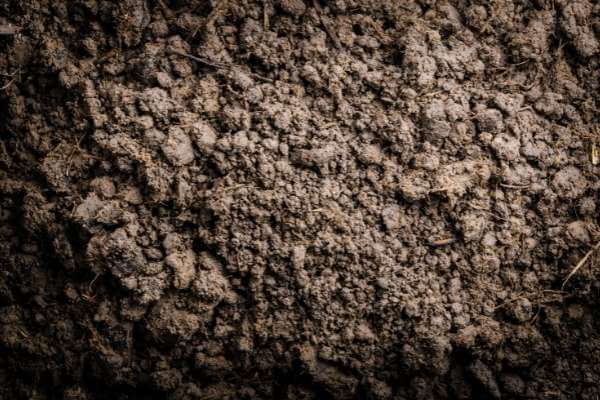
Soil is the most important environmental factor when you are starting with any type of plant.
To grow long beans, the soil should be loose, rich, and well-drained soil. The average Ph of the soil should be between 6.0 – 7.5 which is acidic to slightly alkaline.
Because many of the long beans varieties having some kind of deep rooting systems, I recommend you to work on preparing the soil for at least 1 foot deep.
For me, growing long beans at home is so easy because the only thing I need to prepare a good soil for them is compost.
Long beans are completely satisfying when they are being planted on compost amended soil. Furthermore, you can also some fertilizers or rotted manure to implement the soil for more.
Watering for long bean plant
When we get into watering our long bean plants, I have to say that long beans are one of the thirstiest vegetables to grow.
In my point of view, the main reason for that is we are growing long beans in high temperature and warm conditions.
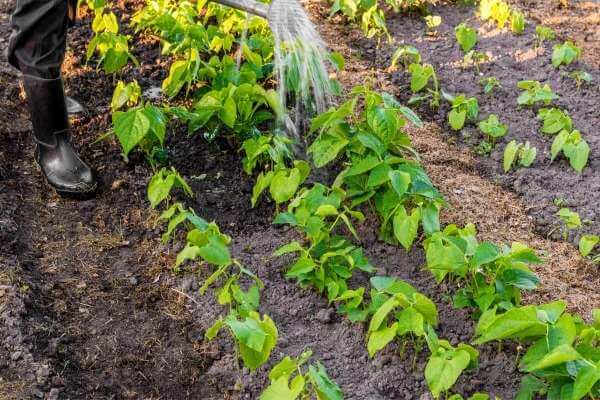
Averagely long bean plants need at least 2 inches of water per week to grow. This will totally depend on the temperature and moisture of the soil. You have to do watering long beans whenever the water dries out from the soil completely.
And whenever you are watering your long beans, water into the base of the plants, not the leaves. I’ve got into trouble with fungal when I put too much water on the foliage of my bean plants.
Also, remember that the morning is the best time to do watering long beans (better between 7 AM-10 AM). But watering this kind of summer growing crop at night can push the plant for severe damages.
Here’s what happens when you water your long bean plants at night.
Now you may ask, how often should I water long beans?
I know you have this problem. So I reached out to some bean growers on Facebook and asked the same question.
And most of them said that they are watering their long bean plants every two days in the hot spells. You have to be very careful of consistent watering because if the soil dries too much on long beans, they can’t produce flowers, and the currently hanging pods will get wilted.
It’s possible to use mulch on the bean plants in such hot spells in summer. it will help to hold water for a bit longer and helps the plant to grow better with less water.
As I have seen, long bean plants like to have more water in their flowering season. I like you to extend your watering onto long beans when they start to bloom flowers.
But never overwater when you are growing long beans. They are pretty strict with you in that matter. The plant leaves turning yellow and the long bean pods will start to be rotten when you do overwater on them.
You need to increase or decrease the watering completely based on temperature, rain, and humidity.
Fertilizing long bean plants
Including long beans, every type of beans and peas are legumes that fix Nitrogen on their roots. So they are naturally adapted to make their own food on the roots.
Therefore, the first thing you should note when fertilizing long beans is that you have to fertilize low Nitrogen on them.
According to USDA, Nitrogen-rich soil encourages long bean plants to leaf abundant, and over time it reduces the crop of bean pods.
Do you need to fertilize long bean plants?
As long beans are legumes that make their own food, do we need to fertilize long beans anymore? You might be thinking like that.
I ran a survey among some bean growers and asked “Do you fertilize bean plants?”. Here’s what I’ve got.
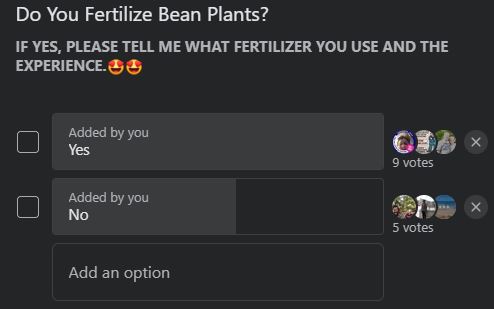
As to the survey, 64.29% of gardeners are using additional fertilizers to grow long beans. The rest of the 35.71% are just left they bean plants to rely on their own food.
And the people who do fertilize their beans have said, they are using natural low – Nitrogen fertilizers for their bean plants. Also, they are seeing a huge improvement in the harvest when they are using fertilizer to grow long beans.
So finally, we can decide that we need to fertilize long bean plants if we need to make them grow better and have a good harvest.
As a low-Nitrogen fertilizer required to grow long beans, compost is the best fertilizing option which usually has 2% – 3% of Nitrogen when comparing to other nutrients. And also compost can be easily prepared at home.
Because long beans aren’t that heavy feeders, you can have good results just from amending compost into the soil. But still, you can make it massive by using another low-nitrogen fertilizer every 3 weeks.
I prefer using some bone meals onto my bean plants as an additional fertilizer every 3 weeks.
Temperature & Sun requirments for long beans
You have to provide the heated temperature for growing long beans, than any other crop.
Do you know how important is the temperature and sun for long beans?
Here’s something to know.
Usually, both long bean vines and shrubs start flowering when they grow long and wide enough. To make them grow quickly, they should get that high required temperature and plenty of sunlight. But when they don’t have it properly, they delay the flowering until they get that heat on them.
Long bean plants need 65 F – 85 F of temperature to grow well, start producing flowers, and set them to fruit. Both vine and bush varieties need that high temperature to run longer and to get extended.
The average soil temperature to grow long beans is 60 F as they love warm soil. Long beans need to have at least 69 F of temperature to germinate their seeds quickly.
Not just the heat is enough to grow a better performing long bean plant. Long bean plants need plenty of direct sunlight throughout the day.
So as many Asian farmers do, choose the most open place in your backyard to grow long beans. Make sure that it doesn’t get shaded by something else in the afternoon when the plant should get the most traction from the sun.
How to start and grow long beans
From here, I’m going to talk about the exact steps that I’m using to grow long beans. You can have the information from sowing the seed to harvest the long bean pods!
First of all, let’s see when we need to start growing long beans.
When to start growing long beans?
As I mentioned earlier long beans love heat, and they are having a growing season close to 80 days. So considering both of those facts we need to decide when to start growing long beans.
Usually, spring has two months, and summer has 90 days on average. As regarding the heat temperature conditions, long beans can be grown in both spring and summer. But early spring is the best time to start long beans because then you will save time for another growing season in summer.
Also, it doesn’t matter if you start seeds indoors, one or two weeks before the last frost day, and directly transplant your long beans at the beginning of the spring. It’s up to you!
Soil preparation for long beans
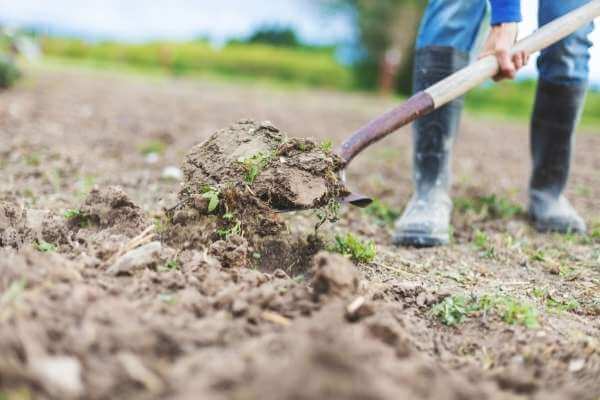
Soil preparation is the first step of start growing long beans, and it’s one of the most important parts of it. Because if the soil preparation goes wrong, it will affect the plant’s growth, health, and harvest.
Let’s see how you should prepare the soil to grow long beans.
The first thing you need to do is till the soil well. This step is very important because tilling the soil helps to make the soil loose, and supports absorb of water and oxygen easily.
On the other hand, you can also remove weeds when you do till the soil.
Once you do till the soil, I want you to till it as deeper as 5 – 6 inches. Then you have to add some compost to the soil and mix it up very well. If you don’t have any compost at the moment you can use a general vegetable garden fertilizer.
I was so impressed with this vegetable garden fertilizer on Amazon, as it has almost the same nutritional intent when comparing to compost.
However, the above soil mix is what we are going to use as the top soil layer to grow long beans.
Now you have to dig 1 feet deep holes which we are going to use for growing long beans after implementing with some nutrients.
You may feel like digging one foot is too much, try to dig at least more than 0.5 feet. The deeper you dig, the better the plant.
Here’s why
Long beans having nearly two months of the growing season. When we using a much deeper hole to plant them, we can implement the soil for those two months by filling enough nutrients for that planting hole.
In my experience of growing beans, the best way to grow long beans is growing in a compost trench. It providing enough fertilizing for the plant throughout the growing season.
Don’t know what’s a compost trench?
Compost trenching is a way of making compost by burying food scraps. And growing on a compost trench means, burying food scraps under a plant, which are turned into compost over time.
So you have to bury food scraps 5 – 6 inches high from the bottom of your 1 feet planting hole. If your planting hole is not that much deep, fill in food scraps halfway of the hole from the bottom.
I do one more thing before filling the rest of the hole from the soil mix. But it’s totally optional.
You can use some slow-release fertilizer on the food scraps. It will make the composting process much quicker, but it keeps the nutrients of the compost on the soil much longer than usual.
If you wish to use one, I recommend you this awesome slow-release fertilizer on Amazon, that can keep the nutrients for a very long time on the soil.
That has been working excellent for me!!
Now you can fill in the rest of the planting hole from the soil mix.
That is how you can prepare the soil for growing long beans. Now we are going to see how you can sow long bean seeds on that planting hole.
Sow long bean seeds
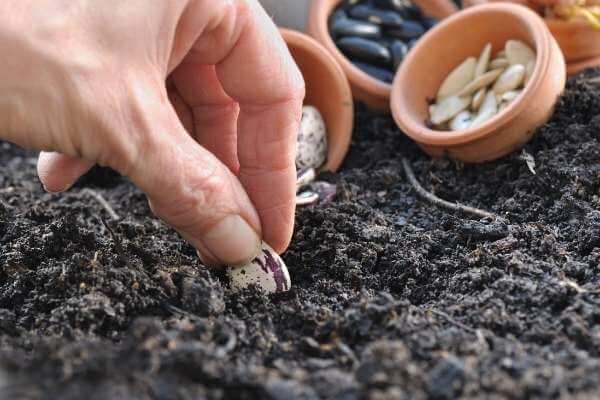
When considering growing long bean seeds, you have to sow long bean seeds nearly 1 inch deep whether it’s bush long beans or vine long beans.
But there is a thing to remember.
As I explained, you are going to sow your seeds in a pre-arranged planting hole. Long bean plants require some spacing between plants to grow without any disturbance.
So according to the spacing requirement to grow long beans, you have to consider where you should dig planting holes, and where you should sow seeds.
Here’s it.
Spacing requirments for long beans
Bush long bean plants require more space between them, than vine long beans.
When growing bush long beans, space between two plants should be 20 cm, and space between two rows should be close to 70 cm. The space between two plants should be at least 30 cm for vine beans, and spacing between two rows should be 90 cm.
Now if we come back to the topic before, consider these things when you are going to dig planting holes to sow long bean seeds.
- What type of long bean is growing (bush or vine)
- Spacing requirements for the relevant type
From now you are ready to sow the seeds to grow long beans. But still, I pull you back from doing it.
You know why?
There is one more thing that I do before sowing bean seeds. That is to keep away from sowing and leaving the soil and the planting holes alone for 2-3 days.
I know that sounds weird to you. But it’s a growing technique that many Asian farmers doing when growing many kinds of crops including long beans.
Here’s the science behind it.
When the soil with composts and kitchen scraps leaves for some time, microorganisms begin to grow on the soil. After about three days, the growth and efficiency of the microorganisms continue to increase more on the soil.
When you are starting after 3 days, long bean seeds will have perfect support from the soil, because it has been more implemented by microorganisms. Therefore it will lead to a healthy start and quick germination.
Cool no. 🙂
How to sow long bean seeds
Now let’s see the exact way to sow long bean seeds. And this is how I did it for 6 years, which made me a bumper of the crop.
If you are growing bush long beans, you have to use only one seed per planting hole. But if you wish to grow vine-long beans, you can sow 2 – 3 seeds per planting hole.
The method of sowing both the vine and bush long beans is the same. Here’s how to do it.
- First, dig for 1 inch on every planting hole.
- Then put the seeds into the hole (only 1 seed if bush beans can use 2-3 with vine beans). Now cover it from the soil.
- Water it well until it absorbs enough water.
- Use a mulch layer on the top of it and water on the mulch layer again.
And that is how to sow seeds to grow long beans. Now let’s see how the seeds germination process works for long beans.
Long beans seed germination
For long beans, 69 F is the average required temperature for the quickest seed germination. And also the soil should have the required temperature of 60 F for a better germination process.
Here are some quick tips for yardlong long bean seed germination.
- If you feel that your area doesn’t have that required temperature to the long beans seed germination, you can provide a mobile greenhouse condition to your seeds by covering them from a white glass or bottle.
- When you feel that your soil is not up to the temperature requirements, you can use a black plastic layer on the soil, which can absorb more sunlight and heat over time.
- Wrap in the seeds in a wet paper towel, a day before planting them. That will quick up the bean seed germination process significally.
- Don’t water to the seeds while its germination, if you wan’t to see a quick and success emerging of leavse.
How long does it take for long bean seed germination?
Instead of answering this question from only my experience, I surveyed some bean growers and asked, “How long does it take for long bean seed germination?”.
Here’s what they said.

According to data I’ve collected from a survey among bean growers, 78.125% of growers said that they took almost a week to germinate long bean seeds.
18.75% of them said that it took only 2-3 days to germinate the long bean seeds.
Usually, it took 6-8 days for seed germination all the time I grew long beans. So when I consider my experience and the survey, we can easily have the conclusion of answer.
Long bean seeds taking a week of average time to complete the germination process. It can be delay or quick by considering the relativity of growing conditions and the weather for the seed germination.
Supporting your long beans
Supporting is kind of a special task in the process of growing long beans. Good support will tend the long bean plant to extend more comfortably, which helps to produce more pods.
From vine and bush types, you only need to support vine long beans. Bush long beans don’t care that much about supporting.
When and how to support long beans?
Long bean vines need support to grow their runners from the beginning of the plant growth. Once the plant gets 0.5 feet tall, you have to train its running stem to grow vertically on a stake.
You have to point the stake 2 inches away from the plant, and train the long bean stem to run on the stakes by wrapping the stem around it.
You need to watch it carefully I the beginning of the plant. Cause it may try to run away from the stake. Then you’ve to wrap them again onto the stake.
When the plant grows longer and extends, you can use more stakes around it according to the requirement.
This is the most easiest and basic way that you can use supporting to grow long beans. Watch the below video to learn more about supporting bean plants.
From this point on, continue the process of watering and fertilizing the long beans as to the requirement.
Above in this article, I have covered all you need to know about watering and fertilizing long beans.
Long bean plant caring and implement growing
Now you know the way t grow long bean plants correctly. But still, there are some actions you could take to care for long bean plants, and also implement the growth of long bean plants.
Let’s jump right in!
Plant diseases and pest attacks on long beans
Several plant diseases can be often seen on long beans, while different pests are more likely to distract the growing of long beans.
Let’s find them out and see what are the solutions we have.
Plant diseases on long beans

- The most common diseases I’ve seen on long bean plant is root rot. Overwatering and the wet soil is the main reason for root rot disease on long beans.
When a long bean plant gets infected by root rot disease, you can easily find it from roots turning brown and rot. Over time all the stems will turn brown and leaves get wilted and turn yellow.
The easiest way to prevent root rot is being careful of watering. Also, make the soil drainable as much as you can. Clay soil is really encouraging root rot on these plants.
- The main disease we can see on long beans, other than root rot is rust. Rust diseases on long beans mainly caused by fungal activities on the plant.
Once the rust disease happens when growing long beans, you can easily identify them by yellow, rust, or brown colored spots on the leaves and pods of the long bean plants.
Here’s how you can prevent rust from your bean plants.
Here are some more diseases that can occur on long beans and their fixes.
Pest diseases on long bean plants
Many kinds of pests are likely to harm bean plants. Let’s see which of them can see more often when growing long beans.
The most commonly seen pest attack on the long bean plant is happened by the insect called bean fly. They look like a housefly, but they look too smaller than them because they are 2mm long on average.

This is what happens when long bean plants get damaged by bean flies.
- When a bean fly attacks a bean plant, you can see that there are yellow-colored spots on the leaves of your plant.
- To find out if bean flies have damaged your long bean plant, look for an unusual knot at the base of the plant. If you find unusual knots on the base of the stem, your bean plant maybe got in trouble with bean flies.
- Also, another way you can identify the attack of bean fly is, by observing if new roots are sprouting from the plant on above the ground level.
- Finally, the long bean plant begin rot rot their stem and could be die if you don’t take any action.
Here’s the reason for the above observations.
Firstly, bean flies are attacking the foliage of the plant. Bean flies pierce the stem and go inside. Then lives by laying eggs inside the stem.
The place where they pierced the stem will later become a knot.
Also, they damage the inside of the stem. Then the stem and roots begin to rot.
So at this point, the plant tries to sprout new roots from the stem.
How to get rid of bean fly on long beans?
There is a very simple trick you can follow to get rid of bean flies when you grow long bean plants.
You have to collect the soil closer to the base of the stem, every 3-4 weeks after you plant the long bean plant.
This will provide the required surrounding to regrow new roots if the plant gets attacked by the bean fly.
It’s easy as pie. 🙂
If the bean flies harming the foliage of the long bean plant, you can use this kind of improved pesticide spray, which will also work for other kinds of pests on your plants.
Pollinating long beans
Pollinating is an important requirement to produce better and healthy crops from a plant. When you grow long beans, a well-pollinated long bean bed is always producing more healthy pods way quicker than usual.
long bean is a self-pollinating variety, which is depositing pollen on the stigma from its own flowers of the plant.
There are two main ways that pollinating happens for the long bean plant.
- Through insects
- By air
When comparing bush beans and vine beans, vine long beans are more likely to be pollinated through the air, because their flowers are well-exposed to air rather than bush bean flowers.
On the other hand, you can work on attracting more pollinators to your long bean plants and give them room to be pollinated more.
The easiest and the most common way that we used to attract pollinators to our plants is by growing pollinator-attractive plants near them.
Try growing these plants to attract pollinators while you’re growing long beans.
- Butterfly bush
- Coneflower
- Dhalia
- Daisy
- Sunflower
- Lavender
Here are some other ways that you could attract more pollinators to your long bean garden.
Hand pollinating long bean flowers
Simply, hand-pollinating is, pollinating flowers with human intervention. Let’s see how can we use hand-pollinating for better long bean growing.
The easiest way you can hand pollinate long beans is by giving your long bean plants a gentle shake.
By doing that pollen grains will be released from the pollens, and they will be deposited on the stigma of female flowers.
The above hand-pollinating method will be working for both bush and vine long beans.
There is another way that you could hand pollinate your beans, by manually depositing pollen grains on stigma from your hand.
But that method doesn’t work practically for a crop like long beans. Because long beans producing too many flowers, you can’t waste your time by pollinating each flower from your hand.
Therefore, giving a good shake to your long bean plants will be totally enough if you doing hand-pollinating on them.
Companion planting for long beans
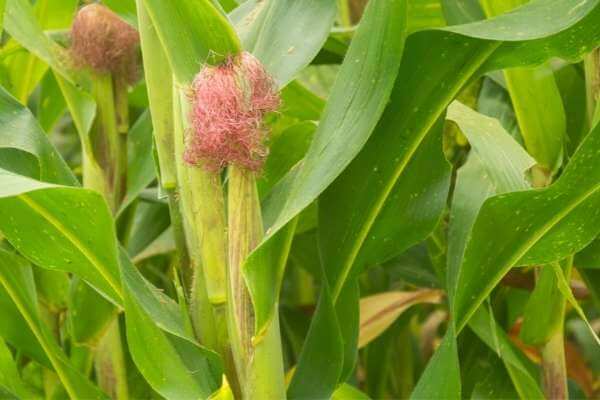
When it comes to gardening, compare planting could do magics with the crop we are growing. Now let’s find out about companion planting for long beans.
Should you do companion planting while growing long beans? Here are some advantages of companion planting with long beans.
- It helps to attract more pollinators to the plants and it will increase the long bean harvest.
- With the help of companion planting, you can repel many insects and pests that harming long beans.
- As I observed, growing long beans with companion planting makes more delicious and flavored pods.
- Supporting each other plants with the soil.
- Can work as a support.
The main thing you have to consider when choosing companion plants to grow with long beans is, not choosing the plant that isn’t required the same natural conditions.
When both long bean plants and companion plants required similar conditions, they will compete with each other to fulfill their requirements.
Also, when both the main plant and companion plant have the same rooting depth, they will compete on the soil to extend their rooting.
When comparing the natural requirements of the plants, the best-suited companion plants for long beans are corn, squash, and zucchini.
And those are the most popular companion plant for growing long beans.
But, because of the different growing qualities of bush and vine long beans, they are different types of companion plants to grow, for bush long beans and vine long beans.
Companion plants for bush long beans
These are the best companion plants that perform better when growing bush long beans.
- Beets
- Celery
- Cucumber
- Radish
- Peas
- Strawberries
Companion plants for vine long beans
Here are some of the best companion plants that you can grow next to long beans.
- Carrots
- Catnip
- Celery
- Cucumber
- Peas
- Potatoes
- Radish
- Spinach
- Oregano
Here are the best companion plants for insect repellants and attract pollinators for long beans.
- Cilantro
- Radish
- Arugula
- Oregano
- Marigold
What not to plant next to long beans
Now, you know what you should plant next to long bean a companion plant.
But there are some plant varieties that could drag beans completely opposite direction from healthy growth.
Don’t grow these plants companion with long beans.
- Chives
- Leeks
- Garlic
- Onions
- Brassica family plants
- Cabbage
- Cauliflower
- Kale
- Broccoli
- Sunflower
Especially, plants like Chives, Leek, Garlic, and Onions release a secretion that kills bacteria in the roots.
Because of that, the Nitrogen-fixing process of the long bean plant is becoming to fail. That isn’t a good sign for the plant.
So that’s how you have to care about companion planting for the long beans you grow.
Pruning long bean plant
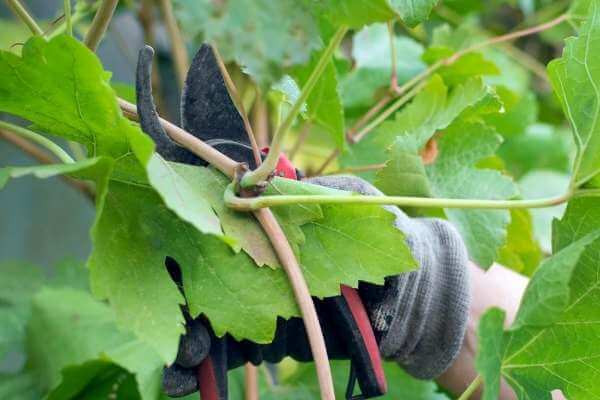
Usually, we pruning a plant to help it get rid of the unusual stress of overgrowing stems and foliage. Also, it will encourage them to work on producing more fruits.
But, should we prune long bean plants?
As long bean plants are growing and directing completely depending on the sun, pruning long bean plants is not that necessary. But pruning the long bean plant at the end of the growing season would be helpful as it helps to produce more quantities of fruits, which are much healthier.
Here’ when and how you should prune long beans.
- You’ve to prune your long bean plant whenever you see the plant is damaged severely by a disease. Cut it down from 4 – 5 inches away from the disease area of the stem.
- Another occasion that you have to prune the plant while growing long beans is, pruning the vine when it’s growing over the supportive stake. Because always we have to keep the vine stuck to the support when we grow long beans.
- When you are getting closer to the end of the growing season, check the stems that have grown so long with more foliage but literally have no flower. Then prune them off. Those are consuming more power of the plant, but not worths letting it happens that way.
Harvesting long beans
After finishing a happy growing season, you will be able to harvest your long beans 60 – 70 days after planting.
Here’s when to harvest long beans.
If you’ve grown vine-long beans, you have to pick them once they are getting into 1 foot long, and when they look in light green to green color.
When growing bush long beans, harvest them once they are 8 – 10 inches long, and when they look light green to green color.
The most attractive thing is, you could harvest long beans every 3 – 4 days after you pick the first bunch of crops.
All you’ve to do when harvesting the long bean crop is, picking them when they are young. Don’t let them hang on the plant until they mature.
You will be not getting the original flavor if you leave long bean pods until they start turning yellow, because of over-maturing.
So keep watching your long bean garden carefully at the end of the growing season. Once you pick young ones, it gives more opportunity to have more crops at the end.
And that’s how you can grow long beans on your own for a huge harvest. I wish you good luck with your bean growing and for all of the plants in your garden. 🙂
